Artists Statement: Axillary Portraits
My current artwork focuses on one particular anatomic region of the body -
the axilla or underarm– and its related hair.
My series of “Axillary Portraits” are inspired from photographs. These
provide the patterns that are then hand sewn and triple-knotted onto
antique handkerchiefs. Friends and willing strangers have been
participating by contributing hair from their brushes and combs, as well
as from haircuts of long ponytails. The larger garment works are made
using artificial hair.
The history of hair phobias and removal is a long and convoluted cultural
story. Both men and women have taken measures, sometimes quite
dangerous measures, to control body hair, including lye-based
depilatories,tweezers, razors, repeated x-ray exposures, and lasers.
Nowadays, few women allow their axillary hair to grow out fully, even
though, like eyebrows and eyelashes, the hair under the arms will only
grow to one’s own unique length and pattern.
Underarms are strangely intimate in a public sort of way. In an age of
easily seen deep cleavage, and visible underwear-thong straps, modesty
still encases axillae, (but only for women).

Building a new artwork for use by the unsupervised public is always a
challenging task. My latest interactive artwork has taken me two years to
complete, and I have learned a lot during the process. It was worth all the
effort!
Here is the finished result: RESTICLES
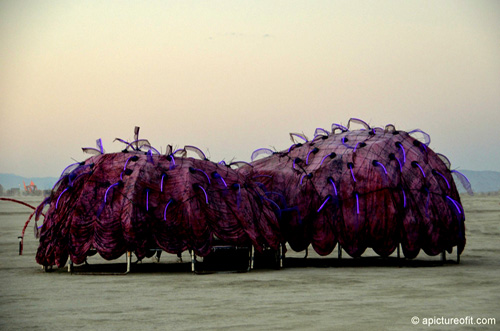



Based on my experience in 2012 making the teeny tiny model for BREASTSTOP, I created a larger macquette for ease in visualization and trouble-shooting. It was incredibly helpful when asking other people for advice or assistance as they could see what I had in mind.


Tie-dyeing the two 28’ diameter parachutes in two hard-plastic wading pools was quite an undertaking! Fortunately the parachutes are 100% cotton, and take dye easily. I spread them out to dry over my car (hidden under there with all the doors and windows open), as well as on tarps on the hot driveway.
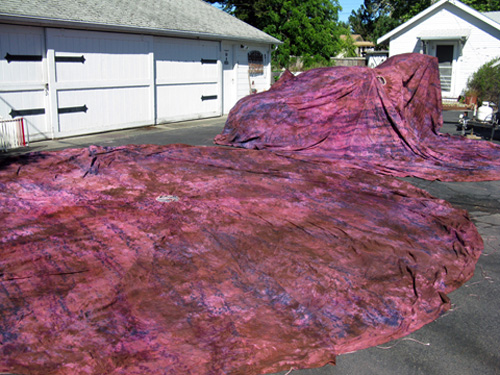

The armatures: two 14’ trampolines, and lots of 1” pvc pipe, and some steel structural components to support and strengthen everything.
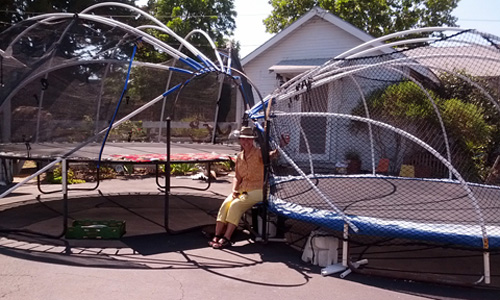

On the high ball the first draping of the parachute is only secured at the hem.
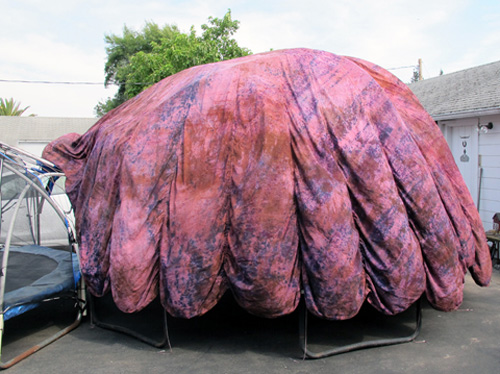

The carpeted entrance step helped people get on and off the trampolines, and functioned as a container for the 6 batteries (36 volt each) that charged off the solar system for the 3000 LED’s used in the hairy lighting. Additionally, having the title on the entrance surely helped visitors to know just what I had in mind.


Loading the trailer is always a challenge, but Aileen is a champ, and between us we are the packing wizards!
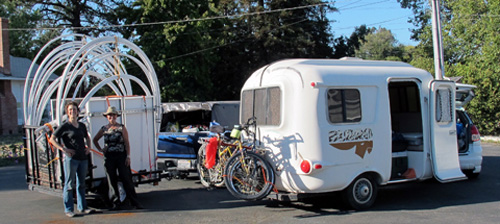
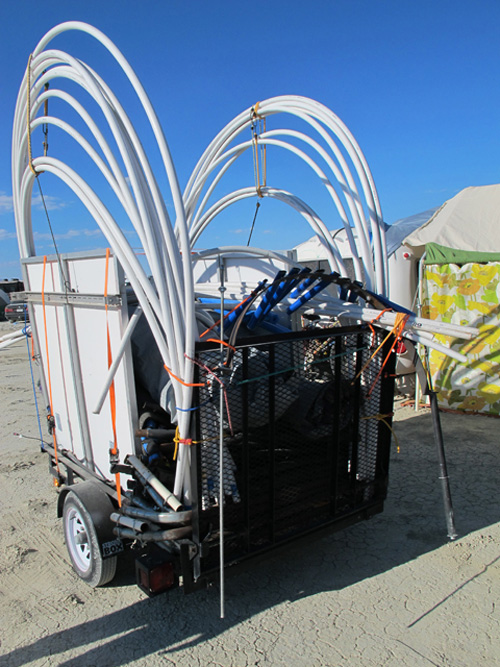

The first image below was taken while standing atop a nearby artwork. Lower right are the six solar panels charging the light system. The other photos below were screen-grabbed from various videos or other photos.


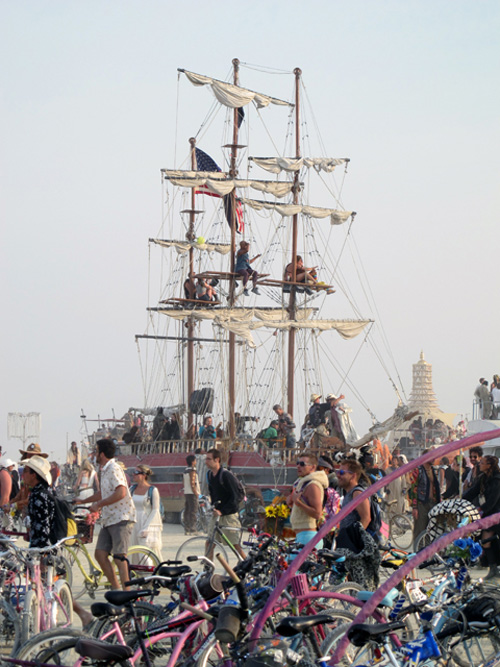
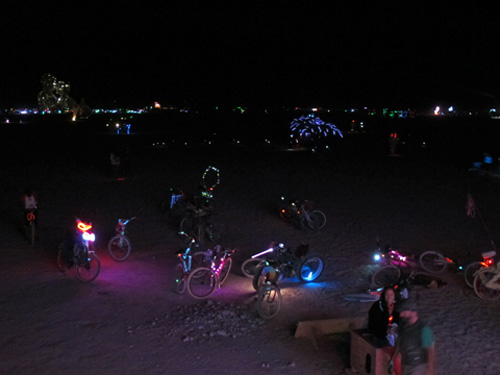
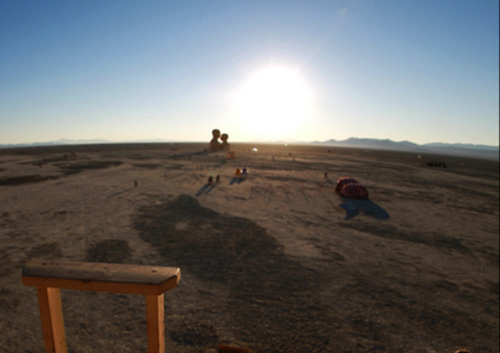


In order to get everything home, I had to load the artwork into my little camping trailer. Another friend took the solar panels and the batteries as the extra weight was more than I could carry.
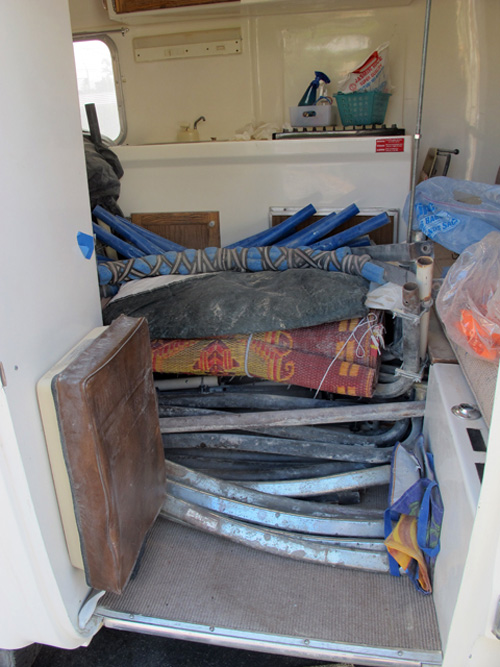

Back home everything gets power-washed. The hairy lights at mid-point in their clean up.
Here are a few of my favorite items that were gifted to me this year. People donated bicycles to me as a fund-raising idea, and one bike came with these GIANT nuts attached to the seat. I don’t think the young man knew exactly what I had created for this year, but these were Perfect!
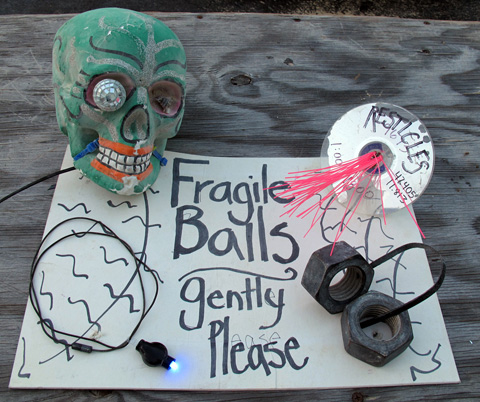

BreastStop
By Heidi Shuler
through a megaphone
Tits boobs bosoms buzooooms-
twin pink parachutes arc over
two round trampolines.
Come inside, jump, back flip,
feel the point of nippledom
20 feet above your head.
Be the bouncing from inside,
dizzying. Rest flat
on your back and look up,
feel the pink sun radiate
through thin skin, this convex
kindness, and you are welcome
to suckle sustenance, innocent
as you once were.
A Suggestion:
If you wish to see these hairy artworks as drawings or abstractions, may I suggest that you skip the Axillary Portraits Artist Statement. May you enjoy the hairy artworks for the delightful textures and sensual juxtapositions that they may offer to you.

Artist Statement: Axillary Portraits
My newest work focuses on AXILLARY hair, more commonly known as underarm hair.
The series of “Axillary Portraits” are inspired from photos I have found on the internet, as well as the many photographs I have taken of the underarms of obliging friends.
Individual artworks are titled “Pheromone Antennae” with a number indicating their creation sequence. Antennae (pronounced: an-ten-knee) is the plural of antenna, and humorously refers to the individual hairs, each of which is hand-sewn by me. Some of the portraits contain a few hundred hairs, and some have many hundreds of hairs carefully sewn into antique and retro handkerchiefs. Friends, and strangers willing to participate, have contributed hair from their major haircuts, as well as their brushes and combs.

Photo: Backside of “Pheromone Antennae #6” from the series “Axillary Portraits”
- - - - - - - - - - - - - - - - - - - - - - - - - - - - - - - - - - - - - - - - -
The underarm (axilla) region of the body, and particularly the hair in this region, has some curious cultural baggage. Underarms fall into an odd grey zone socially: neither public nor private. They are intimate in a public sort of way. Nowadays, few women allow their hair to grow out fully. (Some women may grow their hair in the winter months, but overall, shaving or hair removal is the cultural norm.)
This seems a pity because I find this area of the body to be greatly underappreciated; the hair pattern, and the hair itself, can be softly beautiful.
Each of us has our own individual hair pattern and growth length. These lengths and patterns are unique. In an age of easily seen deep cleavage, and visible bum-thong straps, modesty still encases the underarm region. Many people consider the hair under the arms to be basically off-limits for public viewing.
Then there are those people who find underarm hair as lovely and inviting as I do. One friend told me that seeing a woman’s underarm hair was like a glimpse, without the details, of her pubic hair. Sexy. Public. Is this sexiness why we tend to alter these axillary regions?
“If you really think about it, underarms and crotches are physical, visual, olfactory, gustatory and philosophical metaphors for one another, so any ambiguity or uncertainty in the images actually contributes to the artistic interest and impact.” Anonymous

Definitions relating to Axillary Portraits
A pheromone (from Greek phero "to bear" and hormone, from Greek "impetus") is a secreted or excreted chemical factor that triggers a social response in members of the same species. Pheromones are chemicals capable of acting outside the body of the secreting individual to impact the behavior of the receiving individual.
The axilla (a.k.a. armpit, underarm, or oxter) is the area on the human body directly under the joint where the arm connects to the shoulder. It also provides the under-arm sweat gland.

Thoughts on Hair
I realize that many people may not find underarm hair appealing.
It is a common reaction. On the other hand, men's hair seems so acceptable (under their arms at least), while women's hair is not.
For many people, a beautiful woman is suddenly horribly unattractive once her hairy armpits are noticed. A handsome man with hairy underarms is perfectly acceptable. A woman with hair under her arms is gross. This is curious.
A lovely person is still lovely - hair or not!

May 22, 2013
BreastStop went to the Maker Faire, and received an Editor’s Choice Award!!

My favorite response of the weekend was by a 9-year old girl: “These are the most beautiful….. {long pause}…..cupcakes I have ever seen!”


Hundreds of children had a chance to play inside while their parents relaxed outside.
- - - - - - - - - - - - - - - - - - - - - -- - - - - - - - - - - - - - - - - - - - -- - - - -
Thank you to all my friends who helped set-up, and break down the artwork. Thank YOU to Don Fluitt for manning the entry way and helping to keep the kids at manageable numbers. A very special THANKS for my midnight rescuers who helped me pack up and to finally get on the road!!!
 May 1, 2013
May 1, 2013
BreastStop is going to the Maker Faire!
BreastStop, the interactive artwork I created for Burning Man 2012, is going to be installed at the Maker Faire this spring, 2013.
The dates are Saturday, May 18th from 10am to 8pm, and Sunday, May 19 from 10 to 6pm.
Drop on by, relax, and check out this artwork! It is a sweet spot! Or perhaps I might say: They are sweet spots!

Photo: One of the ‘spare nipples’ has been turned into the signage for the artwork.
I still need to build the support base.
Late September 2012
I took BreastStop, an artwork I created over the surface of two 12’ trampolines, to the Black Rock Desert for the Burning Man Festival. Lots of things happened on the trampoline mats inside the domes: meditations, picnics, naps, parents and kids, gay men, straight women, couples,
lesbians, people who liked to jump, (and sometimes groups of people who liked to jump!) For people who danced until the wee hours, the domes were a great place to catch a snooze. It offers an unusually calm environment and provides an intimate place to meet and mingle with new
people.
I was particularly excited to hear that the final destination and party spot for the Critical Tits Parade would be at BreastStop. When the 5000+ people arrived all at once to this artwork, my friends helped to keep the number of people inside each breast to a safe 11 or 12 headcount. The party went on!

photos by Christine Tweet
One incident during the festival week caught me by surprise: Someone, perhaps standing outside, perhaps in an attempt to escape the wind, managed to catch the hem area of the cotton parachute on fire. Luckily, some people inside noticed, and were able to quickly put out the fire.
A few days later when visiting the artwork a visitor heard me talking about it, and told me he was there, and that he and some other people used their water bottles to extinguish the fire. Yeah for water bottles!
Here is a photo taken back at home showing the damage done. I removed two full gores from the overall parachute, reworked the top ring, and reset the stops for the tie-downs. The result: one breast has had reduction surgery, with modest scarring.

 Bone Installations
Bone Installations In 2009 & 2010, after gathering tens of thousands of bones, I created six artworks. The first installation group of five I titled: “Box of Time: From Bones to Barbie”. The following year, I added a sixth element, and reinstalled them as “Inside the Box of Time”.
More recently, in August & September of 2012 I selected two of the six (“Stars & Stripes”, and “Jaws & Barbs”) for a two-person exhibition at the Lost Coast Culture Machine gallery in Mendocino, CA.
Susan Field created three large wall-hung artworks and I installed the two boney clotheslines. Together we created one artwork in the small Project Room, which we titled “Here There Here”, which was also the title for the overall exhibition. See the photos in the New Work gallery.
In that space I made some videos of my clotheslines, as it was a rare opportunity to see my artworks with a clear/unobstructed/uncluttered background.
Insert videos: to be edited…
May 15, 2012
About a third of "the Barbs" are heading to NY for a Barbie exhibition. 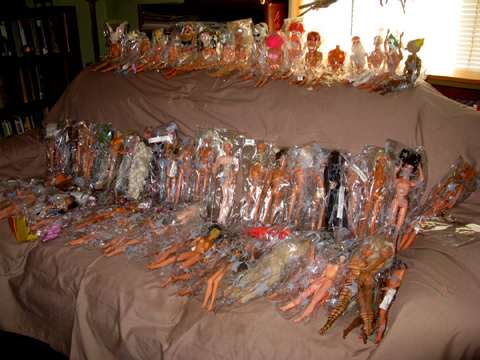
Just a peek as they get sorted and packed up.
Under the sponsorship of the Sonoma Valley Museum, the students in
Sonoma Valley created big eyeballs to illustrate their color theory project.
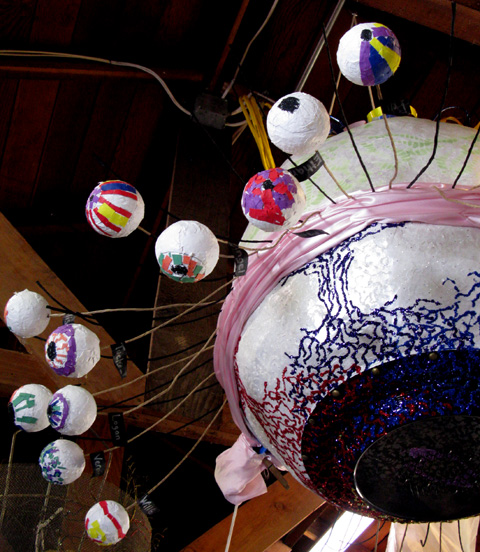
I made this big paper mache eyeball and have temporarily attached the students artworks. When the student exhibit comes down the little eyeballs will go back to their creators, and the new black eyelashes will be attached to my giant eyeball.
July 3, 2010
This video was made by Billy Carmen for The City of Sebastopol. Together they have created a series of videos to highlight a selection of the many artists in this lovely region where we live and work.
The Sebastopol area offers an incredibly wide range of artistic creations and adventuresome artists. Here is Billy's visual impression of my studio, as well as me talking about art and art making.
May 27, 2010
Wow, nearly a year has zipped by since my last writing!
My crew, Vicki, Aileen, Victoria, and I drove our caravan of vehicles to Black Rock Desert. First, we set up our camp, and then over the next few days we set up my artworks. After that the gates opened and 50,000 Burners arrived. Needless to say, it was a fantastic week, full of wild
fun, silly adventures, and delightful moments... hours... and days.
I am now planning my next journey back to the desert.
In between this yearly event, I have been making art, working on my house, puttering in my garden, and aiding my teenage son towards his senior year in high school.
In the busy life of a modern person, a homeowner, and a parent, it is a wonder that anyone can ever make art!
Onwards!
August 17, 2009
At the end of this month, I, and my crew of three women artists, will drive up to Black Rock Desert and install the six boney structures out in the Playa of Black Rock City for the annual Burning Man extravaganza. Furniture for resting will accompany each of the structures.
Back at my campsite we will also install my four "Clouds with Barbs&Bones" as perimeter markers of the Boney Croquet Court. The wickets and stakes will be appropriately outfitted in bones and doll parts.
Additional arty-boney elements will accompany the court installation to create an overall camp theme... Bones, Barbies, and More Bones.
Perhaps we will see you there!!

view from the driveway towards greenhouse and temp.
shade structure/work area

under the shade structure in the work area. detail of some bones

detail view of the 6' market umbrella frame.

overview of the 6' diam. market umbrella frame
other structures in the background

this structure is very low, with cots for reclining.
draft version.

detail shot of 'jaws & barbs'

view from my work area towards driveway.

condensed view.
one, on its side in the foreground
three others scattered around,
and some hanging stakes to the left side.
Sept 26, 2008

i found this (art) bomb in the Black Rock desert during the burning man festival.
when approached (in between the ticking.....) a voice recording was activated in
the device bush's voice talking about war, about the future... "Bring it on!" ... etc
... etc ...
a few minutes later two Bureau of Land Management law enforcement fellows
came up to me we talked awhile. pleasant fun conversation. one of them gave me
a new BLM chapstick, with hemp oil, (kindly pointed out to me) I gave them a truemajority.org collapsible frisbee with a pie chart depicting the federal budget...
and whooee! what an enormous CHUNK for the Pentagon!

just one short memory from bm.

May 29, 2008

"In the Universe We Are Alien"
is the title and the text of my current art project.
I reflected,
I chose hankies,
I printed text,
I boarded an airplane,
I traveled north to south,
I embroidered text,
I invited people to participate,
I took photos,
I returned home,
I reflected,
I selected new hankies,
I printed travel images onto hankies,
now, I unveil them to the public for the first time.
Within my display, I will add hands, dolls, and whatever else pleases me.
Combining images of people, textile relics, and text respectfully reconnects
me with life,
Making art in this way amuses and stimulates me,
and helps create my future.
I present all of this to you.
I hope these composed elements
help you pause,
smile
and reconsider
your wonderful place in this world.
May 12, 2008
Traveling with Art: In the Universe We Are Alien
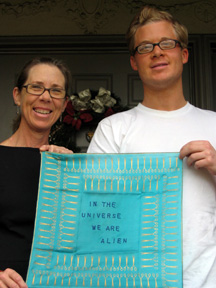
In the fall of 2007, I returned to Italy to travel alone for the first time in 20+
years. The night before leaving, after all my bags were packed, I went up to
my studio to begin an art project that I had envisioned just a few weeks before.
I ink-stamped text onto linens --- something light enough to carry with me
everywhere. I could easily work on embroidering the inked text whenever the urge
or the place presented itself.
I flew directly into Venice and spent the first evening roaming around until quite
late. That night, I met a Taiwanese couple on their delayed honeymoon. Ray
spoke superb English, with subtlety and humor. Iris spoke a bit less fluently, and
he often stopped to translate the difficult bits for her.They sat together and held
the white hanky artwork as I took my first photo in this series. So began the
adventure of creating this project.
The next day, I went to the cemetery island of San Michele. In several places,
I hung the pink-hanky-clothesline between graves and took photos. I met a Scandinavian family and took their photo with the pink clothesline. I quite
unexpectedly stumbled upon a Colotti family mausoleum, cleaned and swept it,
weeded the flower box, and then photographed the site. After a full day taking
photos of wonderfully ornate graveyard sculptures and various odd and appealing things, I waited to board the last boat back to the main cluster of islands.
Attempting to turn off the flash, permanently, in the preferences, I accidentally
deleted over 400 photos. I considered crying, but didn't.
Over the next few days, I went to many of the Venice Biennale sites, met with
visiting relatives, and spent hours roaming various corners of Venice and the
greater Veneto region. I met Wilai, a Thai woman, and together we went back to
the cemetery, taking more photos (but not as many as that first visit), and
roamed around some of the outer islands together. Everyday was easy, despite
the cold, rainy weather, and a cough I had picked up.
One evening, walking back to the train station with Marco, a cousin, and his gal
friend, I saw a pink house, with red and pink laundry, and quick as a wink, I pulled
my pink clothesline out of my bag, and another photo was made.
I had been in Florence the year before, but could not get into the Grotto in the
Boboli Gardens due to its limited hours. This site had been highly recommended to
me by Susan Danis, an incredible artist, so I knew it was definitely top notch. Two tourist information offices and many phone calls later, I had the limited-opening schedule (3 times daily, 15 minutes only) and an explicit "no guarantee" the staff
would stick to the schedule. I awoke early the next morning, and went to explore
the garden before the grotto opened for the first scheduled viewing of the day. In
the distant lower garden, I met an American couple, Gordon & Janet, and strongly suggested they cross the whole garden with me to the grotto. We were not
disappointed! For the next few days, the Pitti Palace and Boboli Garden staff
were on strike. Ah, how lucky we were!
I still speak of smattering of German from my year living in Vienna. My
Japanese, once conversational, is still usable, although after 30 years since
my time in Kyoto, my vocabulary has shrunk. My recent study of Italian is
limited, but enthusiastic. With these languages, I could introduce myself to
many people. I would offer to take their photo at a beautiful site, or start a
conversation about the art we were looking at somewhere. If the mood
struck, the people were appealing, or the situation just suggested itself, I
would select a hanky or the clothesline, and invite people to participate in
my art project. So as not to blind people, as well as to save battery life, I
tried not to use the flash. I rarely took more than two photos. Surprisingly,
these simple restrictions made the project flow more smoothly.
I tried to share this project with as many people as feasible, in the most
enjoyable way and in the least-obtrusive manner as possible. People love to
be included in art projects, and I enjoyed including them in mine.
There were missed opportunities, of course. Some people with whom I spent
time and wished that I had photographed them with hankies: Beppe & Lizetta;
Claudia & Manuel; Mimmo, Marina, & Graziella; Stefania & Daniella
After Florence, I stayed a few days in Pesaro with a cousin, Roberto, and his
family. He had found me on the Internet earlier in the year and his generous
and happy nature was truly welcoming. From him, for the first time, I was
able to know the name of my grandfather's hometown.
From Roberto's home, I took a long train ride south to visit Sant'Agata di
Puglia, my grandfather's birthplace. Previously-unknown-to-me relatives
picked me up at the train station (Thanks, Roberto!) and drove me through
the countryside and up to the little hill town with a tiny castle on top. They
lent me their summer home. It was a few days before the Italian version of
the Day of the Dead (which is considerably more somber than the Mexican
version). I visited the cemetery and found many graves of family members.
At the town government offices, I found old family records. The people at
the Pro Loco (a tourist/publicity office) were friendly, helpful, and fun. The
men dawdled and mingled in the cold wet piazza below while the women
stayed warm inside, sat around, and told jokes. People came in and went out
-- a regular hubbub of laughing and activity!
I visited with Carmella, a neighbor woman, a few times, and was surprised to
see the assortment of taxidermied large birds and small animals placed
around her home.
I ate some fantastic foods: paparadella con funghi, and a strange and
wonderful dish, served only at this time of year, with plump grains, mixed
with a dense sauce made with tomatoes, chocolate, and wine. Before served,
fresh pomegranate seeds were added. OHMIGAWD Delicious!! (It was sort of
similar to a Mexican mole, but without the chili peppers.) I have asked, but I
do not know the recipe yet.
From this little hill town, I took a bus to Naples, then a train to Salerno. The
youth hostel there is lovely, and has a great location. Everyday I explored in
another direction. Pompeii, Paestum, Ercolano, Sorrento, or Naples. In
addition, everyday I explored another part of Salerno.
One afternoon in Salerno, I hiked up to the castle on the mountain overlooking
the bay. There I met a funny fellow, Pino, and as we spoke in English, I helped
him to improve his pronunciation of a few words: group and grape. But then he
got confused and asked about grope. After explaining that word, we laughed
and laughed. We spent a lot of time goofing off, trying to use these words in
the most confusing ways possible. Bruna joined in, and group, grape, grope
will never be the same to them again.
At Pompeii in the Villa di Misteri, (House of Mysteries), I was helping two
American nuns with directions and began chatting with them. They were
happy, fun-spirited nuns; I asked to take their photo with an art hanky.
Just outside the gate near the Villa di Misteri, I had a coffee at the stand-up
bar of a restaurant. The barrista was an unpleasant and grouchy young man,
but the cashier was sweet and friendly, and we struck up a conversation. I
noticed his eye colors and commented, which delighted him. It wasn't until he
came around the counter to hold up an art hanky that I saw his crutches and
leg braces. A few years ago an accident had crippled him. The contrast
between the barrista and the cashier was striking.
Here and there I met other women traveling alone. I met several Japanese
women in different places, a few Americans, and Wilai, the Thai woman. As a
woman traveler, it was relatively easy to travel alone. It was easy to talk
with other women, and couples. There were a few awkward times when I
entered a restaurant alone and they didn't quite know what to do with me.
Put me near that big group of people in the otherwise-empty dining room?
Tell me that the restaurant was reserved for the evening? Only one
restaurant, (that was in Salerno), turned its back to me and refused to
serve me. The place I finally ate that night treated me like an honored
guest, and served me fantastic food! In fact, it was one of the best meals I
had during the entire journey.
In the medieval section of Naples is a district of doll makers. These are not
baby dolls, nor Barbie dolls. These are dolls used for worship in churches, and
placed in homes for nativity scenes. The "set designs" vary from simple
styles to extremely elaborate constructions, and many sizes and qualities in
between. One place I visited had a permanently installed nativity scene filling
a room of about 400 square feet. None of the dolls were very big, maybe 18
inches tall. Some dolls are smaller, to create a forced-perspective. People,
animals, buildings, landscaping of hills, trees, and waterfalls, and a thousand
accessories are all carefully placed to support the compositional focus of the
nativity setting.
I wandered about this old section of town, as I had done the year before,
buying hands and feet, and an occasional head. I shared photos of my own
artworks made with dolls. Some were surprised. Others amused.
When I returned home, I continued to carry these hanky artworks with me
for the next few weeks. Many people -- many strangers, and many friends
have helped contribute, and to them I say:
Mille Grazie (A Thousand Thank You)
Claudia & Roberto Colotti
Elio Rochetti
Marco Colotti & Katy
Wilai
Beppe & Lizetta Colotti (Happy 50th Anniversary!)
Melissa Doerken
Mimmo ('non ti preoccupare), Marina, & Graziella Colotti
Michela Maruotti
Sant'Agata di Puglia Pro Loco
Steve Habkirk
Maurine Doerken
Marianne Fulton
Teresa Book Webster
Deborah Hayner
and especially, Bill & Henri
VIEW SLIDE SHOW

May 16, 2007
Last summer a visiting gallery director suggested that I pack away
my older
artworks so as to de-clutter and refocus the visitor's (and
my own?) experience.
At the time, this seemed like an impossible task,
but I kept the suggestion in the
back of my mind. Now, many months
later, I have arrived at the same conclusion.
I have drawn
the line at about two years - any artwork older than that got
packed
up and put away. EVERYTHING! Even my favorite things that I have had
on the walls, and on the shelves in the house for years. Even the
little things
that I have kept on the dresser in my bedroom. My living
room walls are now
refreshed with finished work from the past two
years. In my studio I have only a
few finished pieces in the space.
The remainder of the artworks in the studio are unfinished pieces.
And raw materials. Many raw materials. The stuff that all
assemblage
artists collect. STUFF!
Now, as I
sort through even the stuff of my raw materials, I come to a new
phase
in my artmaking. For example, I look at the old ceramic
kiln cones and know that I
will never need them again. Send them
out! Give them to a ceramic friend. For a
while I had considered
making assemblages with big furniture-sized items. But I
have
to store these things, and move these things around, and I no
longer desire
to work larger than I can safely manage alone or
store easily.
There may be
exceptions to these 'rules', but, by and large, I find comfort in
this
new setting of priorities. I cannot do everything, nor store
everything, so facing
such realities makes it easier for me to be
in my studio.
It was a daunting
task to begin sorting out and packing away my artworks. It is
an ongoing
task to sort and select which items will remain in my studio as raw
materials. But both of these actions have given me a sense of unanticipated
comfort and relief and freedom.
Embrace change.
It opens doors. Or at least clears some space for something
new!
Mille Grazie (A Thousand Thank You)
Claudia & Roberto Colotti
Elio Rochetti
Marco Colotti & Katy
Wilai
Beppe & Lizetta Colotti (Happy 50th Anniversary!)
Melissa Doerken
Mimmo ('non ti preoccupare), Marina, & Graziella Colotti
Michela Maruotti
Sant'Agata di Puglia Pro Loco
Steve Habkirk
Maurine Doerken
Marianne Fulton
Teresa Book Webster
Deborah Hayner
and especially, Bill & Henri
VIEW SLIDE SHOW

May 16, 2007
Last summer a visiting gallery director suggested that I pack away
my older
artworks so as to de-clutter and refocus the visitor's (and
my own?) experience.
At the time, this seemed like an impossible task,
but I kept the suggestion in the
back of my mind. Now, many months
later, I have arrived at the same conclusion.
I have drawn
the line at about two years - any artwork older than that got
packed
up and put away. EVERYTHING! Even my favorite things that I have had
on the walls, and on the shelves in the house for years. Even the
little things
that I have kept on the dresser in my bedroom. My living
room walls are now
refreshed with finished work from the past two
years. In my studio I have only a
few finished pieces in the space.
The remainder of the artworks in the studio are unfinished pieces.
And raw materials. Many raw materials. The stuff that all
assemblage
artists collect. STUFF!
Now, as I
sort through even the stuff of my raw materials, I come to a new
phase
in my artmaking. For example, I look at the old ceramic
kiln cones and know that I
will never need them again. Send them
out! Give them to a ceramic friend. For a
while I had considered
making assemblages with big furniture-sized items. But I
have
to store these things, and move these things around, and I no
longer desire
to work larger than I can safely manage alone or
store easily.
There may be
exceptions to these 'rules', but, by and large, I find comfort in
this
new setting of priorities. I cannot do everything, nor store
everything, so facing
such realities makes it easier for me to be
in my studio.
It was a daunting
task to begin sorting out and packing away my artworks. It is
an ongoing
task to sort and select which items will remain in my studio as raw
materials. But both of these actions have given me a sense of unanticipated
comfort and relief and freedom.
Embrace change.
It opens doors. Or at least clears some space for something
new!
..............................................................................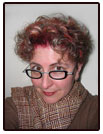
January 15, 2007
Creating
the installation artwork "double consciousness" yielded
some intriguing elements. Half a dozen of these elements are shown
on the home page. A few of
the clustered arrangements can be seen
in the last few images in Gallery 3. I
thought it would be good
to see a few up close. Both of these images contain
animal teeth.
One was photographed in my studio, against the corrugated roof.
For the other, Iphotoshopped out the background, and added color.
During the making
of this installation various friends came and helped create the elements.
The main criteria I gave them was "to combine the bones and doll
parts
with copper wire until an aesthetic balance was found between
the forms and materials." ...>>
January 9, 2007
In October, during a visit to Italy, I had the opportunity to visit
an interesting
church in Rome. La Chiesa della S.S. Concezione is a church of the Cappuccini
monks.
The monks have exhumed hundreds (thousands?) of bodies from their
historical cemetary and arranged them into pleasing compositions.
Some people
came, looked, and then complained that they found it disgusting
or gross. They
didn't have to come and look, but they did.
Myself,
I thought they were pleasing and appropriate and inspiring...>>
www.cappucciniviaveneto.it
December 19, 2006
To purchase Barb Notecards:
Send cash or money orders to my address on the contact page.
$3.00 each or $25.00 for ten cards (with hot pink envelopes).
On
the black/white side is a line drawing of an old suitcase,
and on the other side is the color photo of the doll artworks,
of course, minus the titles...>>
December 18,
2006
For the past several years I have been handing out a notecard of "the
Barbs". It
shows the inside of a suitcase packed with dozens
of my artworks from the doll
series. Until now, it wasn't possible
to include the individual titles. Personally, I
like titles. Titles
provide a clue, or a reference point from which to view the work.
Sometimes, titles are just fun. Sometimes they are very serious.
I will let you
be the judge of which is what.
"the
Barbs" NOTECARD
December 16,
2006
Do you have any idea how many steps it takes to create and post a
new
website?! It is an amazing amount of work... but then again, all
simple-looking
things are not necessarily simple to do. Similiarly, much of my artwork is done with
a minimalist's approach, and yet,
they are often complicated to actually construct.
Three years after
posting my first website (now in the archives), I am thrilled to
be
having some more of my artwork put up on the web. Many of these artworks
were created in the last three years. A few are older. In contrast,
Concrete Hand
is new, and not yet finished.
I hope this website
gives you the opportunity to see the variety of materials, the
range
of techniques, and the scope of my concerns for content. I am happy
to be offering these little representations on the web.
Not surprisingly,
I have many more artworks to share. I look forward to doing just
that! Welcome, and
please enjoy.
deborah
p.s. a GRAND Thank You to Deborah Hayner for her vast assistance!!
I am angry. I am hopeful. I am cynical, yet full of humor. Whereas my
working
environment is surrounded by vast natural vistas for peaceful appreciation,
my
studio is loaded with objects and references gathered for their qualitative
symbolism, as well as their emotive and aesthetic appeal. My mind roams around seeking connections between the absurd and the commonplace that I then pare
down to essential personal and social symbols. As I arrange
and rearrange the
objects layered meanings are revealed and developed.